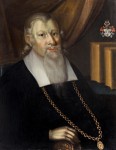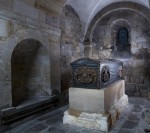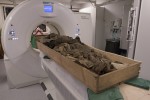 The mummified body of Peder Winstrup, Bishop of Lund from 1638 until his death in 1679, is being studied by researchers from Lund University who have discovered that not only are his remains extraordinarily well-preserved, they are not alone in the coffin. Underneath the bishop’s feet are the skeletal remains of a four or five-month-old fetus.
The mummified body of Peder Winstrup, Bishop of Lund from 1638 until his death in 1679, is being studied by researchers from Lund University who have discovered that not only are his remains extraordinarily well-preserved, they are not alone in the coffin. Underneath the bishop’s feet are the skeletal remains of a four or five-month-old fetus.
 Peder Pedersen Winstrup was born in Copenhagen in 1605, the son of theologian, professor and Bishop of Sjaelland Peder Jensen Winstrup. (They were Lutheran bishops, not Catholics, obviously.) The young Peder followed in his father’s footsteps, studying theology at university. After graduating from the University of Copenhagen in 1633, Peder quickly rose through the clerical ranks. He was appointed royal chaplain to King Christian IV in 1635; three years later he was appointed Bishop of Lund. He remained in the position after the transfer of the province Scania from the Denmark–Norway empire to Sweden in 1658, even though there were doubts as to his loyalty to his new monarch King Charles X Gustav. He repeatedly encouraged the king to found a university at Lund which was finally done in 1666, eight years after Winstrup’s first letter to King Charles suggesting he establish a university. Winstrup presided over the university’s inaugural ceremonies and was appointed its chancellor in 1671.
Peder Pedersen Winstrup was born in Copenhagen in 1605, the son of theologian, professor and Bishop of Sjaelland Peder Jensen Winstrup. (They were Lutheran bishops, not Catholics, obviously.) The young Peder followed in his father’s footsteps, studying theology at university. After graduating from the University of Copenhagen in 1633, Peder quickly rose through the clerical ranks. He was appointed royal chaplain to King Christian IV in 1635; three years later he was appointed Bishop of Lund. He remained in the position after the transfer of the province Scania from the Denmark–Norway empire to Sweden in 1658, even though there were doubts as to his loyalty to his new monarch King Charles X Gustav. He repeatedly encouraged the king to found a university at Lund which was finally done in 1666, eight years after Winstrup’s first letter to King Charles suggesting he establish a university. Winstrup presided over the university’s inaugural ceremonies and was appointed its chancellor in 1671.
 When the good bishop died, his body was entombed in the family grave in Lund Cathedral. During an extensive program of restoration under architect Axel Nyström in 1833, the Winstrup tombs had to be moved. The exceptional condition of Peder Winstrup’s remains was noted at the time and documented by an artist. They were moved again several times during the 19th century until in 1875 all of the Winstrup family coffins were buried together in the cemetery with the exception of Bishop Peder Winstrup’s. The fine condition of his remains and the fact that he had no other marker in the cathedral inspired officials to keep his tomb in the church crypt.
When the good bishop died, his body was entombed in the family grave in Lund Cathedral. During an extensive program of restoration under architect Axel Nyström in 1833, the Winstrup tombs had to be moved. The exceptional condition of Peder Winstrup’s remains was noted at the time and documented by an artist. They were moved again several times during the 19th century until in 1875 all of the Winstrup family coffins were buried together in the cemetery with the exception of Bishop Peder Winstrup’s. The fine condition of his remains and the fact that he had no other marker in the cathedral inspired officials to keep his tomb in the church crypt.
 In 2012, officials decided to relocate Winstrup’s tomb in Lund Cathedral to make space for the increasing numbers of visitors. At the same time, researchers at the Lund University Historical Museum found an old photograph of the bishop’s remains taken when the coffin was opened in 1923. His clothes, including a velvet cape and leather gloves, were perfectly intact and his body was in such good condition that his face, while shrunken, was still entirely recognizable from portraits. Since his rest was to be disturbed anyway, an interdisciplinary team of researchers from Lund University was assembled to study the bishop’s mummified remains.
In 2012, officials decided to relocate Winstrup’s tomb in Lund Cathedral to make space for the increasing numbers of visitors. At the same time, researchers at the Lund University Historical Museum found an old photograph of the bishop’s remains taken when the coffin was opened in 1923. His clothes, including a velvet cape and leather gloves, were perfectly intact and his body was in such good condition that his face, while shrunken, was still entirely recognizable from portraits. Since his rest was to be disturbed anyway, an interdisciplinary team of researchers from Lund University was assembled to study the bishop’s mummified remains.
 What they found is a veritable time capsule of 17th century life, albeit a very privileged one. Winstrup was not embalmed or deliberately mummified. His internal organs are still in place and identifiable in CT scans. The preservation of his remains was a natural process, the result of copious quantities of plant materials occupying fully half of the space in the casket, constant air flow, his death in December and burial in January and centuries passed inside the dry, cool family crypt. Another factor in his unusual preservation may have been his long final decline which left him very thin, a key step in the self-mummification process.
What they found is a veritable time capsule of 17th century life, albeit a very privileged one. Winstrup was not embalmed or deliberately mummified. His internal organs are still in place and identifiable in CT scans. The preservation of his remains was a natural process, the result of copious quantities of plant materials occupying fully half of the space in the casket, constant air flow, his death in December and burial in January and centuries passed inside the dry, cool family crypt. Another factor in his unusual preservation may have been his long final decline which left him very thin, a key step in the self-mummification process.
 Peder Winstrup was 74 years old when he died, and his remains show the tell-tale signs of it. He had osteoarthritis in his knee and hip joints and was missing several teeth. Cavities found in his remaining teeth suggest he enjoyed sugary foods, an indication of high status since most people couldn’t afford much sugar in their diets.
Peder Winstrup was 74 years old when he died, and his remains show the tell-tale signs of it. He had osteoarthritis in his knee and hip joints and was missing several teeth. Cavities found in his remaining teeth suggest he enjoyed sugary foods, an indication of high status since most people couldn’t afford much sugar in their diets.
The first results show dried fluid and mucus in the sinuses, indicating that Winstrup had been bedridden for a long period before he died. Calcifications in the lung could indicate both tuberculosis and pneumonia. Plaque was also found in the left coronary artery of the heart, the aorta and the carotid artery, indicating that the bishop suffered from atherosclerosis.
“The gall bladder also has several gallstones, which could indicate a high consumption of fatty food”, says Caroline Ahlström Arcini, an osteologist working on the project.
Researchers also found he had an injured tendon in his right shoulder that likely limited his mobility to the point that common tasks like putting on a shirt or combing his hair would have been painful.
 It was the CT scan of the bishop’s coffin that revealed the biggest surprise of the study: the tiny baby tucked under his feet. Nobody knew it was there because it’s hidden by the plant matter in the casket and by Peder Winstrup’s voluminous robes. Researchers believe that it was miscarried or prematurely delivered and hidden in the bishop’s coffin by a member of his family or staff, or perhaps someone involved in the preparation of his body for entombment.
It was the CT scan of the bishop’s coffin that revealed the biggest surprise of the study: the tiny baby tucked under his feet. Nobody knew it was there because it’s hidden by the plant matter in the casket and by Peder Winstrup’s voluminous robes. Researchers believe that it was miscarried or prematurely delivered and hidden in the bishop’s coffin by a member of his family or staff, or perhaps someone involved in the preparation of his body for entombment.
According to Dr. Per Karsten, director of the Historical Museum at Lund University, there was a tradition in 17th century Scandinavia of mothers bribing cemetery workers to inter babies who had died before they could be baptized in the coffins of other people so that the little ones would be laid to rest in consecrated ground. There are instances of babies being buried in the very church walls for this same reason. As Winstrup died on December 7th, 1679, and wasn’t buried until January 27th, 1680, there would have been plenty of time for someone with access to hide the baby in the bishop’s coffin without the family’s or his staff’s knowledge.
“You can only speculate as to whether it was one of Winstrup’s next of kin, or whether someone else took the opportunity while preparing the coffin. But we hope to be able to clarify any kinship through a DNA test”, says Per Karsten.
The next step will be investigations into the textiles in the coffin, as well as further study of the body. Tissue samples from the internal organs are to be removed, among other things. In addition, the extensive plant material in the coffin will be investigated.
“a tradition in 17th century Scandinavia of mothers bribing cemetery workers to inter babies who had died before they could be baptized in the coffins of other people so that the little ones would be laid to rest in consecrated ground.” Rather touching.
Yes, if that were the case, I hope the mother was comforted.
what a fascinating mystery – I hope you will tell us the answer when there is one.
I was very happy to see your Blog on the bishop.
While living in Malmo in 1976, I visited the cathedral several times and became aware of the history of the period when Peder Winstrup was bishop. When in 2014/15 I read of the intention of the church to remove and bury the bishop in the cemetery I was disturbed. Even more unset when the university’s research provided so much information. By this time the bishop was a national treasure. Nothing but re-entombment in the cathedral became obvious. I wrote the university. The Skane newspaper contacted me here in Chicago. My cousins in Halmstad saw the story on tv in which my efforts were shared. Happily the bishop was re-entombed in the crypt with full honors. Well deserved I might add.